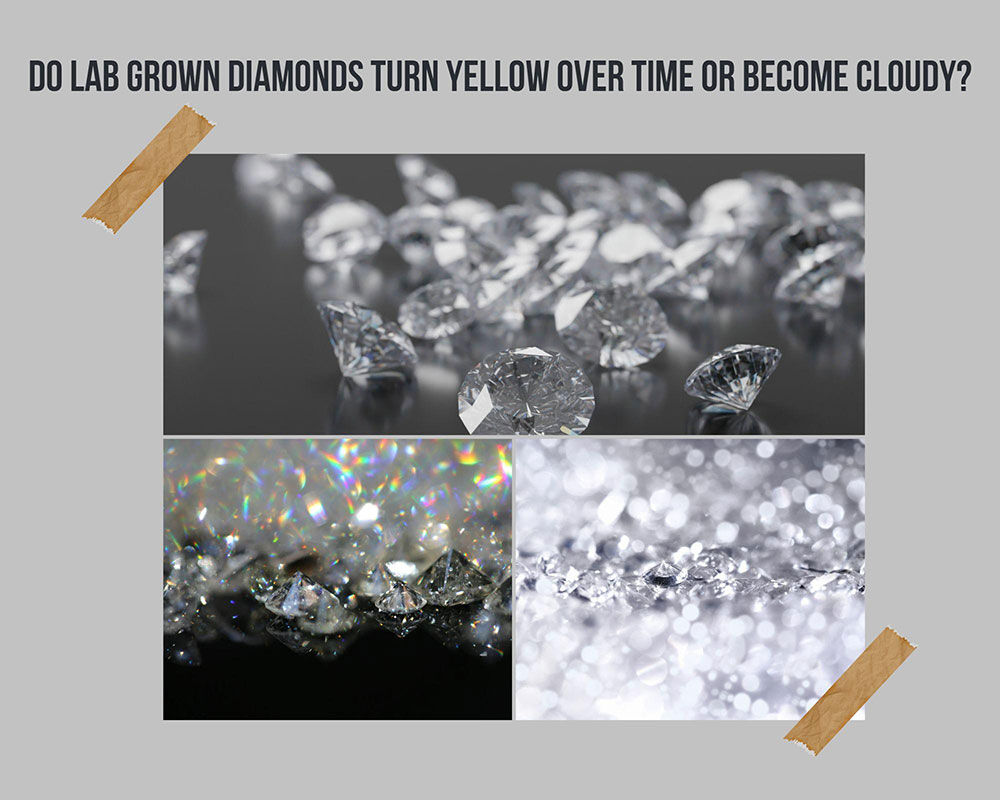Do Lab Grown Diamonds Turn Yellow Over Time or Become Cloudy?

It's easy to get confused about the properties of lab-created diamonds. That's because not all of us are experts, and we should know about diamonds inside out.
Many people doubt their authenticity regarding the background of lab-grown diamond engagement rings.
You're making a big investment when you reach out to a renowned lab-grown diamond maker for their lab-grown engagement rings. And as such, you have a right to ask about anything and everything, including whether the lab diamond will turn yellow or become cloudy over time.
People always need clarification because of the misconceptions that they hear about diamonds and their properties. They're told that lab-created diamond jewelry tends to lose its shine and fade with time. But this isn't true because, like mined diamonds, lab-grown diamonds do not turn yellow or become cloudy over time.
Do Lab-Grown Diamonds Get Cloudy?

When you visit a jeweler, chances are that you'll be told that a lab-created diamond ring will change over time. But this rarely happens.
Lab-created diamonds don't change in either physical or visual appearance. A simple test of placing a piece of lab-created diamond in a sample bottle containing concentrated hydrochloric acid can prove this. The only observation you'll see will be a good and thorough cleaning and nothing more.
It's important to note that some jewelers promote different information about lab diamonds. That's because the cheaply produced cubic zirconia gets cloudy when it oxidizes. But remember that cubic zirconia isn't a diamond but a diamond simulant.
Reasons Why Lab-Created Diamonds Don't Fade Over Time
One of the reasons why lab-created diamond jewelry doesn't fade or become cloudy is that they're manufactured through the HPHT process. HPHT is an acronym that refers to High Pressure and High Temperature. The other process through which diamonds are manufactured is the CVD (Chemical Vapor Deposition).
During the CVD and HPHT process, a mixture of hydrogen and methane gas is placed in a chamber. This enables a diamond to grow on the seed crystal. This technique ensures that the diamond gets all the qualities that prevent it from turning yellow or becoming cloudy over time.
Lab-grown diamonds have proved to be the best in almost every aspect. In recent years only lab-grown diamonds producing companies have become popular among people. Clean Origin is one such popular lab-grown diamond producer in the industry. You no longer have to worry about them turning yellow or losing their shine with time.
Note that just like mined diamonds, lab-created diamonds are well-tested. That's the reason why they're sold on a huge budget level. So if you ever get to the point of buying that tennis bracelet, you should go for lab diamonds.
Cloudy Change Observation
It is believed that small amounts of diamonds produced via CVD are of poor quality, hence changing color when exposed to ultraviolet rays. This may be because the diamonds were grown with vacuums in their M or L color pattern crystal structure.
Once diamonds are manufactured in the laboratory, some are exposed to high radiation. This process causes such diamonds to develop some color change over time. Lab-grown diamonds are carefully subjected to long and short-wave ultraviolet light, which helps to ascertain their phosphorescence, stability, and fluorescence.
Note that you must always take adequate care of your diamond for them to stay sparkling and polished. Sometimes diamonds appear cloudy when exposed to sunlight for a long time. The good news is that the sparkling and polished nature doesn't change.
Diamonds are rated at 10 when placed on a Mohs scale. This means that they fall in the same reading category as rocks. The indelible hard nature of diamonds helps them to maintain their characteristics.
Clarity Issues and Inclusions That Can Make Lab-Grown Diamonds Cloudy
Clarity issues are some of the reasons why a diamond may look cloudy. This is primarily due to the nature of the inclusions. That's what tends to make things get worse as you go lower in clarity grades.
A low-clarity diamond has inclusions like clouds and twinning wisps listed as grade-making inclusions. This calls for extra caution because excessive clouds and twinning wisps can affect the brilliance of the lab diamond.
Note that other tale-take signs in a grading report indicate the possibility of a hazy lab-created diamond. One of the tale-tale signs is an inclusion plot showing a need for more plotted inclusions in slightly included (SI) lab-created diamonds or included (I) diamonds. It's always best to closely inspect before committing to a purchase.
Another red flag to watch out for in a GIA report is the comment, "clarity grade is dependent on clouds that aren't shown." This statement is usually the death kiss of a lab diamond's life and sparkle. And that's because of the severity of the cloud inclusion.
When buying lab diamonds with lower clarity ratings, there's usually a common myth that these gemstones become cloudy because of the presence of cloud inclusions. Some assume other inclusions, such as twinning wisps, can't cause chalkiness issues.
But the many twinning wisps in a lab diamond can be so dense that the gemstone fogs up the stone's outlook.

Dirt, Grim, and Oils on the Surface of Lab Diamond Facets
The intrinsic qualities of a lab diamond can be the primary cause of a cloudy appearance. Sometimes, however, the problem comes from the external cleanliness of the wedding jewelry, for instance.
You will sometimes hear someone complaining about their diamond wedding jewelry not sparkling as it initially did. But when the jewelry is examined, you immediately realize that they don't perform routine cleaning maintenance.
You need to realize that diamonds are a magnet for grease or oil, and that's because their surface mucks up easily. A dirty diamond won't sparkle because light can't enter, and this causes it to appear dull.
So if your diamond studs start getting cloudier over time, know that it's because the surface is dirty. And this can always be fixed and the diamond's luster restored. You only need to take a few minutes to wash and clean your diamond engagement ring.
Can Strong Fluorescence Give Lab Diamonds a Chalky Look?
It's not common for fluorescence to impact a diamond's visual appearance. Sometimes, however, a strong or very strong fluorescence rating can cause the diamond to look oily. This is because of the chemical composition of the diamond and its interaction with light.
Usually, this phenomenon manifests itself in colorless diamonds. And when fluorescence negatively impacts a lab-grown diamond tennis bracelet, the visual effect becomes obvious.
Note that it's okay to purchase diamonds with fluorescence. But you must first examine and review the details before buying. If there are issues, they will show up in videos. Even an untrained eye can pick them out easily. And when you see a cloudy diamond, be smart and walk away. It should be fine with how great the price point is.
How to Avoid Purchasing Milky Lab Diamonds
Greed, stupidity, and insufficient knowledge cause people to make the mistake of purchasing a cloudy lab diamond.
A lot of people unknowingly purchase hazy diamonds. They blindly bought diamonds at "fantastic" prices with no flaws. To make it worse, some consumers blindly purchase slightly included (SI) diamonds based on a grading report.
Keep in mind that there's a reason why some diamonds are priced at ridiculously low prices. Also, shopping for diamonds with a cheap mindset can land you on the shorter side of the stick.
But how can one avoid the mistake of purchasing a diamond that looks chalky? The secret is to buy with actual data, such as scope images and magnified videos.
Remember that buying a slightly included diamond is perfectly okay if you know what you're doing. Eye-clean SI diamonds provide great value for money when their inclusions don't pose any challenge.
Making rational purchasing decisions is something that anyone can do. Even if it's your first time buying lab-created diamond jewelry, you can do it.
Lab-Grown Diamonds Vs. Mined Diamonds
Visually, mined and lab-grown diamonds are exactly the same. They have the same level of hardness and durability. In fact, in 2018, The Federal Trade Commission recognized lab-grown diamonds as real. But the question on your mind might be whether lab diamonds are indeed real despite the report. The answer is yes, they are real.
In fact, The Gemological Institute of America (GIA) has been grading lab diamonds since 2007. Since July 1st, 2019, GIA lab-grown diamond reports and identification reports have not used the term "synthetic" about lab diamonds. The GIA lab-grown diamond report also includes the standard GIA color, clarity, and cut grading scale.
The naked eye cannot differentiate between lab diamonds and mined diamonds. Mined diamonds have tiny amounts of nitrogen. Lab diamonds, on the other hand, have no nitrogen. That's one of the aspects that gemologists use to identify whether a diamond is lab-grown or earth mined.
Mined diamonds are created under the pressure of the earth's crust over millions of years. Once they're ready, they're mined, cut, and polished. A lab-grown diamond is created under the same circumstances, except that it happens in a laboratory setting.
In fact, the process used to manufacture lab-grown diamonds significantly cuts down the growth time. From millions of years in the creation of mined diamonds to just a couple of months for lab diamonds. And just like earth-mined diamonds, lab diamonds also get cut and polished.
Why you Should Buy Lab-Grown Diamonds
There's a new twist to the old saying that diamonds are a girl's best friend. Now it's lab-grown diamonds that are a girl's best friend. Advocates of mined diamonds may not agree with this. But the fact is that jewelers and consumers who love diamonds worldwide are slowly approaching the fact that lab diamonds are chemically identical to mined diamonds.
Today, lab diamonds are increasingly being used to make exceptional diamond jewelry. There are various reasons why the popularity of these diamonds keeps growing. Here are some of the reasons why:
- Greater purity. Lab-grown diamonds are pure compared to earth-mined diamonds. That's because lab diamonds don't have any dirt or impurities ingrained in them. Moreover, they have fewer defects and show fewer signs of strain in their crystal structure.
Greater purity proves that the diamond is poised to be brighter, better, and even whiter. In fact, a huge percentage of lab-created diamonds receive higher purity ratings compared to mined diamonds.
- Guaranteed origins. Many people that love diamonds want to be aware of the journey of their stone from its origin. Unfortunately, the sources of many traditional diamonds can be vague. That's considering that they come from conflicted regions.
Such diamonds have a dark background and may have been sold to fund armed conflicts and civil disturbances. Some diamonds are not sourced from conflicted regions but carry a history of child labor.
They also have a negative history of human rights violations and poor working conditions. Lab diamonds, on the other hand, have a clean record and a guaranteed trackable source.
- Affordability. Colored diamonds sell for inflated prices. This can be attributed to their rarity. Technology has also made it possible for lab diamonds to be available for a fraction of the cost of mined diamonds. What's even better is that they're brighter and perfect. Lab diamonds are also pure, steady in color, and easy to find.
- Environmentally friendly. The mining of traditional diamonds can damage the earth substantially. Mining diamonds uses colossal amounts of fossil fuel. Lab diamonds, however, have none of these issues. In fact, with the continued demand for diamonds, mined diamonds are predicted to dwindle. That's why switching to lab diamonds is a more sustainable choice.
Conclusion
Your sparkling white engagement ring won't break your heart by changing its physical or visual appearance. Not even if the stone is placed in concentrated hydraulic acid. That's because these gemstones are manufactured through the HPHT and CVD processes.
These processes ensure that the diamonds get all the qualities that prevent them from turning yellow or becoming cloudy. We hope this article has been helpful and you can buy that lab-grown engagement ring without worrying about its physical appearance.




